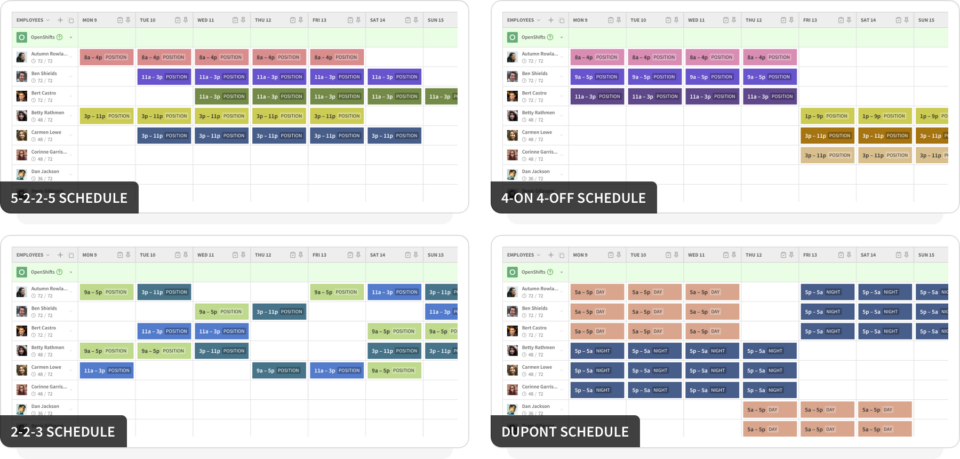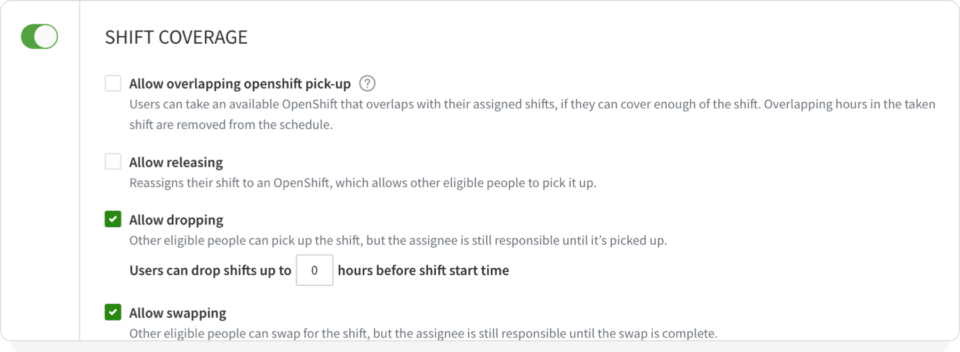Night Shift Schedule Guide: Examples, Challenges, And Tips
Try When I Work for free
Managers handling night shift scheduling know the challenges that come with staffing businesses during late nights and early mornings.
Decreased employee performance, low morale, and difficulty maintaining fairness are just a few of the issues you may be facing. Keeping your operations running smoothly and your employees happy requires the right night shift schedule.
Here are the key things to know about night shift scheduling:
Key takeaways
- Night shift scheduling involves creating employee work schedules during late night and early morning hours, typically between 11pm and 7am.
- Common industries that use night shift scheduling include healthcare, manufacturing, transportation, and security.
- There are several types of night shift schedules, such as the 2-2-3 schedule, the 4-on 4-off schedule, and the DuPont schedule.
- Potential challenges of night shift scheduling include employee sleep debt, ensuring adequate shift coverage, and accommodating employee preferences.
- Effective night shift scheduling involves avoiding consecutive shifts, offering incentives, using consistent rotations, planning ahead, getting employee input, and using scheduling software.
Schedule your night shift more efficiently and keep your employees from burning out with When I Work. Start your free trial today!
What is a night shift schedule?
The process of establishing employee work schedules that operate during the late night and early morning hours, typically from 11pm to 7am, refers to night shift scheduling. Businesses and organizations that operate 24 hours a day, 7 days a week, need this type of scheduling.
Night shift workers are commonly employed in healthcare facilities, manufacturing and industrial plants, transportation and logistics companies, and businesses that require around-the-clock security. Night shift scheduling ensures these essential services are adequately staffed at all hours.
How does night shift scheduling work?
There are differences in the logistics of night shift scheduling based on the organization and industry. However, the general process involves assigning employees to work shifts that cover the late night and early morning hours. Here are some key aspects of how it typically works:
- Employee preferences and time-off requests: Managers collect and consider employee scheduling preferences and time-off requests to accommodate individual needs and preferences.
- Shift length: Typical night shifts span 8-12 hours to ensure operational continuity and coverage during late hours.
- Rotating vs. fixed schedules: Depending on organizational needs and employee preferences, night shift schedules can feature consistent night shifts or a rotation between day and night shifts.
- Staffing needs assessment: Factors such as customer demand, seasonal changes, and employee vacation time determine staffing needs to ensure adequate coverage during night shifts.
- Advance scheduling: Developing schedules days or weeks ahead of time gives employees the necessary notice and opportunity to align their personal lives with work responsibilities, which in turn enhances work-life balance and employee satisfaction.
Night shift schedule examples
Managers can implement several different types of schedules when scheduling night shift workers. Here are a few of the most common examples:

5-2-2-5 schedule
This schedule involves employees working 5 consecutive day shifts, 2 days off, 2 consecutive day shifts, and 5 days off. After this, the pattern repeats, but the employee switches to night shifts.
This schedule balances work and time off, with employees receiving a “mini-vacation” of 5 days off every other week. However, the alternating day and night shifts can be challenging for some employees to adapt to.
4-on 4-off schedule
With the 4-on 4-off schedule, employees work 4 consecutive night shifts of 12 hours each, followed by 4 consecutive days off. Then it repeats.
Employees can recover from the demands of night shift work with this type of schedule. However, working 4 nights in a row can be physically and mentally taxing.
2-2-3 schedule
Also known as the Pitman Shift Schedule, the 2-2-3 approach involves employees working 2 days on, 2 days off, 3 days on, 2 days off, 2 days on, and then 3 days off. It repeats continuously.
The 2-2-3 schedule allows for a balance of work and time off while ensuring 24/7 coverage. However, it can lead to inconsistent schedules for employees.
DuPont schedule
Structured around a 4-week cycle, the DuPont shift schedule features 12-hour shifts that alternate between 4 night shifts, 3 days off, 3 day shifts, 1 day off, 3 night shifts, 3 days off, and 4 day shifts. Then it repeats.
This type of schedule helps minimize sleep debt accumulation by allowing frequent “weekend” breaks.
When I Work makes it easy to use any of these night shift schedules. You can create templates to save time building the schedule each week. Or, you can build out the schedule as far ahead as you need, so you always know what shifts are coming up. Plus, When I Work offers plenty of ways for you to stay organized to make sure your workers are getting a fair schedule that works for them, which boosts employee engagement and productivity.
Common challenges of a night shift schedule
Organizing overnight shift schedules for employees can come with its own array of potential obstacles and difficulties. Some of the most common challenges of night shift scheduling include:
Employee sleep debt
Night shift work goes against the body’s natural circadian rhythms. Employees working overnight often have trouble getting enough quality sleep during the day.
Over time, this sleep debt can impact performance, health, and morale. Managers should strive to create schedules that allow adequate rest and recovery between shifts.
Getting adequate coverage
Ensuring that you have the right number of staff working each night shift is easier said than done. Overstaffing leads to wasted labor costs, while understaffing puts undue stress on workers and can impact operations.
Managers need to determine optimal staffing needs and create balanced schedules accordingly.
Honoring employee scheduling preferences
Scheduling night shifts inherently limits the number of employees willing to work those hours. It’s important to give workers some control over their schedules by soliciting preferences and allowing for shift swapping when possible.
However, managers also need to be fair and equitable when creating schedules, which can be a delicate balance.
When I Work can help keep up with employee availability and time-off requests. Your team can update their availability right within the software, so you know you always have the most recent information. Plus, their availability and time off shows up when you’re scheduling, so it’s easier to honor your staffs’ preferences, which makes for happier workers.

Addressing work-life balance
Employee well-being and job satisfaction depend on maintaining a healthy work-life balance. However, night shift scheduling can disrupt traditional routines and make it challenging for employees to engage in personal and social activities outside of work.
Lack of balance can lead to employees feeling isolated and dissatisfied, affecting their overall well-being.
When I Work gives your employees a place to request time off, update their availability preferences, and lets them swap and drop shifts if necessary to accommodate their work-life balance. All of these features will help your team be more well-adjusted to these necessary night shift schedules.
Increased risk of errors and accidents
Working during the night can impair cognitive function and decrease alertness, increasing the risk of errors and accidents in the workplace. It’s a major concern, especially in industries with a high degree of safety, like healthcare, transportation, and manufacturing.
Management can mitigate these risks by providing adequate training, implementing safety protocols, and scheduling frequent breaks.
Impact on physical and mental health
Working night shifts can have a significant impact on both physical and mental health. Chronic sleep deprivation and disruption of the circadian rhythm can increase the risk of various health problems, including obesity, diabetes, cardiovascular disease, and mood disorders such as depression and anxiety.
Managers should prioritize employee health and well-being through health resources, wellness programs, and supportive work environments.
Tips for creating an effective night shift schedule
If you’re struggling with creating effective overnight schedules for your team, here are some tips to help ease the process:
Avoid scheduling an employee for too many consecutive night shifts
Working multiple 12-hour night shifts in a row can quickly lead to burnout and negative health effects. When possible, try to limit the number of consecutive night shifts to two or three before giving an employee a night off.
Luckily, there are tools to help you navigate this.
A restaurant open 24 hours a day could use a scheduling app like When I Work to avoid overworking overnight staff, such as setting limits for no more than three consecutive night shifts, which the software will automatically flag to allow the manager to make adjustments.
The restaurant can also copy and paste previous weeks’ schedules with When I Work schedule templates, preventing employees from working too many consecutive night shifts. These features streamline the scheduling process and ensure that the restaurant maintains a fair and balanced schedule for its overnight staff, ultimately improving employee satisfaction and retention.

Offer night shift incentives
Providing perks to employees who work the night shift can improve morale and make those shifts more appealing. Consider offering a pay differential for overnight hours, giving extra paid time off, or providing free meals or snacks to night shift workers.
A call center that operates 24/7 could offer a 10% pay differential for any hours worked between 10pm and 6am. Night shift workers may also earn eight extra hours of paid time off per quarter to use as personal time.
Incentives like these make night shifts more attractive to employees. This helps address the pain points of low morale and difficulty maintaining fairness by recognizing the unique challenges of night shift work and compensating employees accordingly. Managing these night shift incentives can be easier than ever with When I Work payroll integration.
Try rotating shifts to give employees a consistent routine
While it may seem easiest to have dedicated night shift workers, putting employees on a consistent rotation between day and night shifts can actually be better for their circadian rhythms. Look into shift schedule templates like the 2-2-3 or DuPont and see if they could work for your team.
A manufacturing plant that operates 24/7 could use a 2-2-3 shift rotation. Under this system, employees would work 2 day shifts, 2 night shifts, and then have 3 days off.
Rotating regularly allows employees to keep a regular sleep/wake cycle and adjust more easily to a changing schedule. You can use the When I Work time clock feature to track attendance, breaks, and time off with ease as employees rotate through different shifts.
Plan night shifts a few weeks in advance
Allowing your employees to plan their personal lives around their work schedule is crucial for maintaining work-life balance and preventing burnout. Aim to post night shift schedules at least two weeks in advance, if possible. You can also use scheduling software to share schedules in real time as soon as they’re published.
A good example of how to do this would be if a hospital uses scheduling software to create and share nurse schedules. The scheduling manager could post night shift schedules three weeks in advance, allowing nurses to plan their personal lives accordingly and request changes if needed.
Ask employees for their scheduling preferences
Getting input from your team is one of the best ways to create a night shift schedule that works for everyone. Regularly ask employees about their preferred shifts and availability, as well as if they have any scheduling requests. Try to honor some of these preferences when creating your schedule whenever possible.
If you own a retail store, you could survey your sales associates about their preferences for working weekends, evenings, or overnight shifts. Then you can create schedules that accommodate their needs and constraints, keeping morale high and improving work-life balance. This helps address the pain points of low morale and difficulty maintaining fairness by involving employees in the scheduling process and considering their preferences.
Use employee scheduling software to automate the process and get real-time data on shifts worked
Relying on manual scheduling processes or basic spreadsheets often leads to errors, excessive administrative work, and limited visibility into workforce metrics. Scheduling software, such as When I Work, can simplify this process.
The software automates schedule creation, distribution, and management, saving time and ensuring proper staff coverage. It provides real-time insights into hours worked, labor costs, and peak demand periods, enabling data-driven decision-making. This data is essential for tracking employee hours, managing labor costs, and forecasting future staffing needs.
Managers and business owners can use the intuitive tools within When I Work to quickly build and publish schedules, handle shift swaps, and track time-off requests. Automating these processes helps reduce the administrative burden on managers and allows for more efficient and accurate scheduling. It also empowers employees to take control of their schedules, improving work-life balance and job satisfaction.
By addressing the pain points of decreased employee performance, low morale, and difficulty maintaining fairness, When I Work scheduling software streamlines the night shift scheduling process and helps create a more balanced and efficient workplace.
Streamline your night shift scheduling with When I Work
Creating an effective night shift schedule that works for your employees and your business is no easy task. Managers must understand the challenges, different types of schedules, and best practices to create an optimal overnight staffing plan.
Using employee scheduling software like When I Work can make the process even easier. It automates schedule creation, tracks employee hours, and allows for easy shift swapping and communication. These When I Work features help address decreased employee performance, low morale, and difficulty maintaining fairness by streamlining the scheduling process and ensuring a balanced and fair schedule for all employees.
See how much time and effort you can save by starting a free trial of When I Work today.






